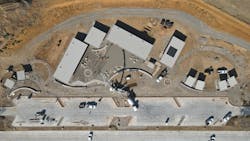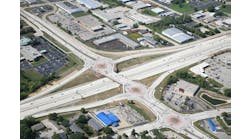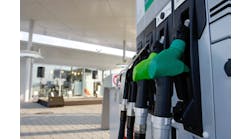By Mark Gudenas and Kristin Dispenza, Contributing Authors
Safety roadside rest areas (SRRAs) were first addressed on a national scale in the Federal Aid Highway Act of 1956. This legislation also outlined funding for the Interstate Highway System.
The Highway Beautification Act of 1965 spurred further investment, and by the end of the 1970s, SRRAs were a reliable convenience along most major highways.
Many rest areas are at an age where they require upgrades, but updating an SRRA means much more than giving it a facelift. In California, it means complying with requirements set forth by the Americans with Disabilities Act (ADA), the Division of Occupational Safety and Health (Cal/OSHA), and the California Green Building Standards Code Part 11, Title 24, California Code of Regulations (CALGreen).
Amenities recently constructed as part of the John “Chuck” Erreca Rest Area Replacement Project, located on Interstate 5, conform to all regulatory requirements and begin a new era of SRRAs in terms of design and sustainability.
In April 2022, the Caltrans District 10 construction team and contractor Walsh Construction Company began work on the Erreca rest area. They have a projected a completion date of September 2023.
As rest areas across the country need rehabilitating to meet the needs of 2023 highway systems, other states can learn from Caltrans’ project.
A Model for the Future
The number of visitors to roadside rest areas has grown over the years, so expanding capacity is key.
“For the construction years 2022 and 2023, average annual daily traffic numbers at the SRRA were 1,800 southbound and 2,080 northbound,” said Navraj Jammu, Caltrans project manager. “By the year 2042, which is the design year – that is, the expected design life of the project – we expect to have an average of approximately 2,600 vehicles stopping at southbound rest area each day and 3,000 northbound. Thirty-four to 38% of these vehicles will be trucks or buses.”
At the project’s outset, over 6,500 cubic yards of soil were moved while re-grading the site, and the existing northbound and southbound comfort station buildings were demolished. Those buildings were replaced with a water treatment facility, new comfort stations, and vending buildings on both north- and southbound sides of the highway, as well as structures for the use by maintenance crews. A wastewater treatment facility also was built on the site.
Concrete was chosen for the project’s pavement, offering a long life while requiring little or no maintenance. The SRRA required over 180,000 cubic feet of concrete to serve as parking spaces for trucks and cars, along with an additional 40 feet of concrete pavement for the on- and off-ramps.
The car parking areas were built using 9-inch-thick jointed plain concrete pavement (JPCP), and the truck parking areas were constructed with12-inch-thick JPCP. Steel dowels were inserted to help distribute loads, and the original asphalt pavement was removed, ground up, and recycled as base material for the new pavement.
“Given our sustainability goals, using hot mix asphalt didn’t fit,” said Jefferson Birrell, landscape associate at Caltrans. “We believe this rest area will be in place a long time, and concrete pavement will last.”
Concrete pavement probably is better suited to withstand the heavy I-5 traffic in California’s temperatures.
“Improving the structural capacity of the parking areas was a goal of this project,” said Michael Smith, infrastructure solutions manager at CEMEX, the cement supplier for the project. “By distributing the load instead of concentrating it, we avoid having it penetrate into the subgrade, which can happen with flexible pavements. Those heavy, concentrated loads on flexible pavement can sometimes even penetrate the base.”
Inderpal Gill, Caltrans transportation engineer, said that the rest area will serve a large number of big rigs and that 18-wheel trucks often drip oil.
“Concrete is not susceptible to deterioration when exposed to oil, so this contributes to its durability,” Gill said.
Caltrans does not take oil drips lightly. Zubair Anwar, Caltrans resident engineer, said they are detrimental to the state of the pavement.
“The damage they cause not only drives up maintenance costs but they also negatively affect a visitor’s experience of the rest area, so avoiding the damage by using concrete will be a benefit,” Anwar said.
An additional sustainability benefit of concrete pavement: It possesses a high albedo, which means it reflects large amounts of light energy from the sun back into the atmosphere, remaining cooler than other pavement surfaces.
“Concrete’s coolness was another feature that made it a desirable choice for the Erreca rest area,” said Smith. “By absorbing less energy due to the reflectivity of the pavement, it lowers the ambient air temperatures and reduces the urban heat island effect.”
Caltrans upgraded utilities as part of its sustainability effort on the Erreca SRRA project. The team focused on low-water usage and low-power demand. This conservation method will serve as a working model for the rest area’s visitors.
Gray water (wastewater from the sinks) will be captured and treated in the site’s wastewater facility, and then reused for flushing toilets. Potable water will be sourced from surface water and treated using an ultrafiltration system.
“The use of filtered surface water is important because it reduces reliance on the state water system during a time when we’ve been hit with a severe drought and consumers have been asked to make cuts in water usage,” said Birrell.
Landscaping was also designed to minimize water use. Landscapers planted indigenous, drought-tolerant plants, and they used the area’s existing vegetation.
Design for the Future But Remember the Past
Caltrans designs SRRAs to architecturally express what makes a specific region unique.
“The region where the Erreca rest area is located used to host Basque sheep herders,” said Birrell. “In fact, it takes its name from one of those men. To honor the area’s history, we have installed graphics on the wall that are inspired by the brands those herders used on their sheep.”
John “Chuck” Erreca was appointed to the highway commission. While in that post, he became a champion of roadside rest stops.
“We are also installing an interpretive display discussing the region’s Basque history, and the design of the paving in the main plaza was modeled on aerial views of farmland to the east,” Birrell said.
The California aqueduct carries water from Northern California to Southern California and is an important part of the State Water Project, supplying water for agriculture, homes, and businesses. The aqueduct runs parallel to I-5 and adjacent to the Erreca rest area. This makes the rest area an ideal spot for educating visitors on the aqueduct and the State Water Project.
The John “Chuck” Erreca SRRA Project cost $37 million and is on track to open in September. Experience gained during its construction will carry forward, informing future rest stop designs and improving sustainability across the system. RB
Mark Gudenas works at Southwest Concrete Pavement Association. Kristin Dispenza works at Advancing Organizational Excellence.



